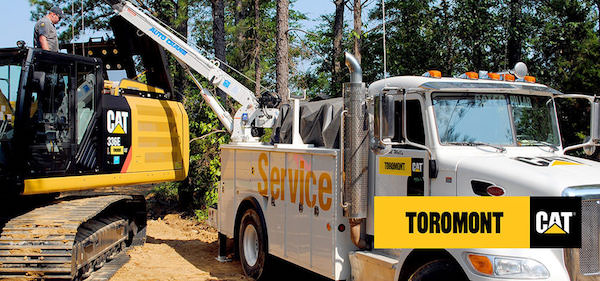More than meets the eye
Given the task of seeing if telematics would help the company improve routing service calls with its 430-plus vehicle fleet, Dave Dyer, fleet manager at Toromont CAT, needed to find a solution that fit the company’s need for accurate, real-time data. Knowing where the technicians are in relation to the service calls would help to reduce customer wait time and minimize the miles driven to get to each job site.Toromont Cat connects its service network and finds benefits it didn’t expect.
Toromont CAT’s fleet costs and challenges were escalating — from needing to improve maintenance management and routing, to increasing billing transparency with customers.
Given the task of seeing if telematics would help the company improve routing service calls with its 430-plus vehicle fleet, Dave Dyer, fleet manager at Toromont CAT, needed to find a solution that fit the company’s need for accurate, real-time data. Knowing where the technicians are in relation to the service calls would help to reduce customer wait time and minimize the miles driven to get to each job site.
To address these challenges, one of Dyer’s first steps was to add telematics and get the surrounding individually operated CAT dealerships to use it as well. In addition to addressing the challenges the company knew it already faced, adding telematics shed light on other issues the company wanted to tackle, such as safety management and fuel efficiency.
After three months of using Geotab, Dyer put his case together for how the dealerships could work together to improve routing across the branches. “Our trucks were criss-crossing each other,” he says. “With telematics, I was able to show how many times we were crossing into each other’s territory every day— that’s fuel we don’t need to burn. So we said, let’s dispatch together instead of individually, so now the trucks are moving shorter distances,” Dyer says. “We were all focused on our own branches, but by dispatching together our expenses come down.” Now customers can have the closest dealership come to service their equipment and pay less on mileage, though they might have to wait longer; or if they need immediate assistance and a dealership further away is available, they’ll pay slightly more on the travel rate. Dealerships now can be completely transparent with customers, reducing billing concerns.
“We can show customers that the guy 15 minutes from you will be ready in three hours, or I can send someone from my branch right now but you’re going to have to pay more on the travel rate,” Dyer says.
Another easy-to-spot routing inefficiency was where technicians were assigned. Since technicians take the trucks home at night, by sharing location data across the branches, managers realized that some technicians were working at a CAT dealership further than the dealership closest to their home. By re-assigning certain technicians to a closer dealership, store locations have been able to save even more on fuel. As a result, branches have been saving significantly on fuel. Dyer says that after the first year of using Geotab, Toromont CAT increased its fleet size by about 18 percent while company fuel expenditures dropped four percent, despite the cost of fuel rising by 22 percent.
For maintenance and safety, the transparency telematics offers is practically endless. For maintenance, Toromont CAT is able to share vehicle trouble code alerts with its maintenance provider for improved preventive maintenance.
Another challenge Dyer faced was the need for better maintenance record keeping. “We had a fairly decent maintenance system, but what we didn’t have was a way to accurately record that data,” he says, citing that this included receiving vehicle fault codes in a timely manner as well as managing regularly scheduled maintenance.
In fact, the Ontario Ministry of Transportation had sent a letter to Toromont CAT urging the company to improve its overall compliance or risk being audited. “There wasn’t anything we could’ve given them for maintenance, although we were doing the work, so that is also what encouraged me,” he says, adding that he wanted to avoid getting audited altogether but also ensure that if an audit happened, the company had the data they needed.
Reducing Idle Time
One Toromont Cat driver was idling 33 to 40 percent of the vehicle’s running time every day. Once he was shown the telematics data his idle time has reduced to three to four percent. That’s good for fuel economy, reduces wear on the vehicle and improves emissions!
Dyer is also a fan of telematics safety aspects. He says that Toromont CAT has had one serious accident since having the system, and by using the real-time GPS information and telematics on driver behavior he was able to prove the company’s driver wasn’t at fault.
The data is also useful for training. Dyer uses it to show drivers what could’ve been done differently in order to prevent a particular mishap, whether or not a Toromont CAT driver was at fault. “It helped us straighten out issues right away,” he says, adding that decreasing accidents has significantly minimized the company’s audit risk. In the same vein, the fuel and wear-and-tear savings achieved by improving driver behavior has been staggering. “You can change the behavior of the driver just by showing them,” Dyer says. In measuring behaviours like idling, harsh cornering and seatbelt use, he gets a graph each week ranking the different drivers and how much more their trucks costs to operate than a driver with fuel efficient habits.
“How you can use the data from telematics is endless,” Dyer says. “I’m even learning today some of the things I’m able to do. The visibility has opened so many doors for us.”
Source: https://www.fleetbusiness.com
FLEET MANAGEMENT NEWSLETTER
Join to our NEWSLETTER; you’ll get the latest news, articles, publications, training, conferences, events, congresses, and white papers related to Fleet Management, Mobility and Automotive IN your email fortnightly.




